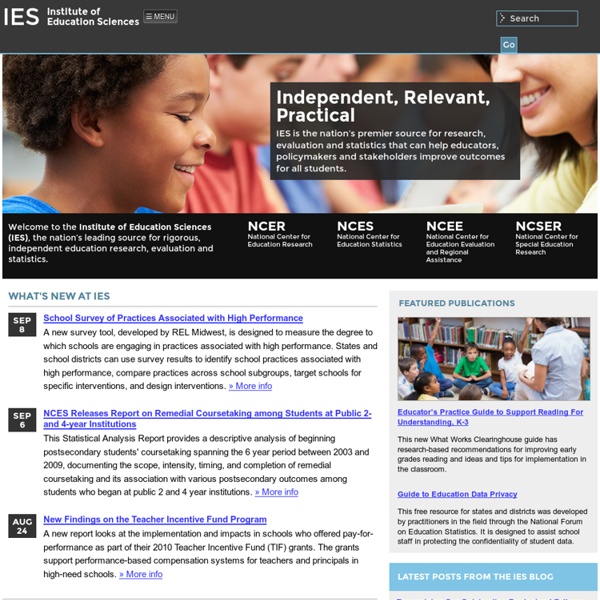



The World Factbook People from nearly every country share information with CIA, and new individuals contact us daily. If you have information you think might interest CIA due to our foreign intelligence collection mission, there are many ways to reach us. If you know of an imminent threat to a location inside the U.S., immediately contact your local law enforcement or FBI Field Office. For threats outside the U.S., contact CIA or go to a U.S. Embassy or Consulate and ask for the information to be passed to a U.S. official.
Premise Data General How many countries do you operate? We’re currently in more than 30 countries across six continents. Top 20 Must-Have Educational iPhone & iPad Apps Used By Real Teachers in the Classroom - iPhone app article - Shara Karasic With the advent of the 2011/2012 school year, teachers who have access to mobile technology are scrambling to find the best education apps for the iPod Touch, iPad and iPhone. Educators use apps for everything from communicating with students to inspiring creativity to dissecting virtual frogs. Luckily, we have lots of educators (including Apple Distinguished Educators) on Appolicious who share their lists of the best education apps for elementary, middle school, junior high, and high school. These are the education apps most listed by educators on Appolicious. 1. 3D Brain (iPad, iPhone.
Diverse Teaching Strategies for Diverse Learners Edited by Robert W. Cole According to Diplomas Count: An Essential Guide to Graduation Policy and Rates (Olson, 2006), the national graduation rate is 69.6 percent. This report estimates that in 2006 more than 1.2 million students—most of them members of minority groups—will not graduate from high school in four years with a regular diploma. Graphic Identity: Logo Leverage the power of MIT. The MIT brand is the best-known and strongest of the many identities across the MIT community. And the MIT logo—the short-hand representation of that brand—is the most recognized graphic identifier. By using the MIT logo in your department’s or organization’s identities and communications, you send a message: you connect with the power and promise of the Institute. Use of the MIT logo instantly tells the world that you are part of the MIT community—and you share in the positive reputation that’s been built over many decades.
North Carolina History: A Digital Textbook - LEARN NC Primary sources, multimedia, readings, and lesson plans to tell the many stories of North Carolina's past. Replace your textbook — or enhance your teaching with selections. Get started Sampler An overview with samples of the kinds of readings, primary sources, and multimedia available. Questionnaire design Perhaps the most important part of the survey process is the creation of questions that accurately measure the opinions, experiences and behaviors of the public. Accurate random sampling and high response rates will be wasted if the information gathered is built on a shaky foundation of ambiguous or biased questions. Creating good measures involves both writing good questions and organizing them to form the questionnaire. Questionnaire design is a multistage process that requires attention to many details at once. Designing the questionnaire is complicated because surveys can ask about topics in varying degrees of detail, questions can be asked in different ways, and questions asked earlier in a survey may influence how people respond to later questions. Researchers also are often interested in measuring change over time and therefore must be attentive to how opinions or behaviors have been measured in prior surveys.
Quick List: iPad Resources For The Classroom One question that comes into my inbox or on Twitter a lot lately is one dealing with iPads in the Classroom. Many schools a all over are investing in iPads in the Classroom and educators want to know how to use them effectively, apps to consider and more. In keeping with the "My Favorite Resources" theme (last week I listed my favorite resources for talking about Twitter) here are my go-to resources when people ask me about iPads in the Classroom. iPads For Education Special Education Lesson Plans For Kindergarten to Second Grade Cave Club Introduction - Student will learn about prehistoric time through hands-on learning activities and other creative art projects.Classroom Etiquette - Raising your hand, asking "please", not calling out without be called on, listening and respecting other classmates ideas.Color Sorting - Sorting colors and shapes.Counting with Dr. Seuss - The student will use numbers and count.Decimal Values and Money - The students will use coins to arrive at the designated total marked on the envelope.Exceptional Children Class Lesson - Students will use their prior knowledge of The Grouchy Ladybug to help them create a mathematical story problem using the grouchy ladybug and the aphids that are to be eaten.How do I feel? - The overall subject would be "Sometimes I feel..."
Delaware County Intermediate Unit {*style:<b><i>Building a Healthier Lifestyle? Put the Big Rocks In First! </i></b>*} This is an old story and you may have heard it before. I had never heard it in the context of wellness and I found it a simple, yet profound idea. A speaker pulled out a wide mouth gallon jar, and placed it next to a pile of fist-sized rocks.